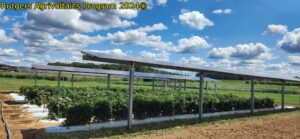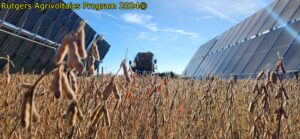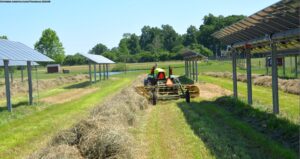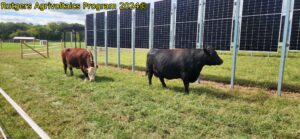The Rutgers Agrivoltaics Program is a multidisciplinary group of Rutgers faculty and staff committed to designing and conducting applied agrivoltaics research and outreach for stakeholders in New Jersey and throughout the region.
The Rutgers Agrivoltaics Program (RAP) was initiated over 3 years ago with the signing and passage of the Dual Use Solar Act by the New Jersey legislature. In 2023, agrivoltaics (AV) research installations were established at three Rutgers-New Jersey Agricultural Experiment Stations (NJAES). One at the Clifford E. and Melda C. Snyder Research and Extension Farm in Pittstown, NJ; one at the Animal Farm on the Rutgers New Brunswick (SEBS) Campus, and one at the Rutgers Agricultural Research and Extension Center (RAREC) near Bridgeton, NJ. Members of the Rutgers RAP Team in collaboration the New Jersey Board of Public Utilities, NJ Department of Agriculture, and NJ-DEP are now in the process of implementing the Dual-Use Solar Energy Pilot Program.

Specialty crops being grown in a double panel AV plot at the Rutgers Agricultural Research and Extension Center near Bridgeton, New Jersey.

An image of specialty crops being grown in a single AV panel plot at the Rutgers Agricultural Research and Extension Center near Bridgeton, New Jersey.
The agrivoltaics research at the Rutgers Agricultural Research and Extension Center (RAREC) near Bridgeton, New Jersey was designed to study the effects of agrivoltaics systems on the production of specialty and agronomic crops. This year eggplant, bell pepper, fresh-market tomato, and soybeans were grown under three different treatments: single-axis tracking array with one row of panels, single-axis tracking array with two rows of panels, and no panels (conventional production as a control) to determine the effects of the panels on crop yield and quality.

Soybeans were grown in two whole blocks at the Rutgers Agricultural Research and Extension Center near Bridgeton, NJ in 2024.

Soybeans being harvested between double AV panel arrays at the Rutgers Agricultural Research and Extension Center near Bridgton, New Jersey.
At the Clifford E. and Melda C. Snyder Research and Extension Farm in Pittstown, NJ the effects of single-axis tracking arrays with one row of panels on forage growth was studied to measure potential impacts on hay yield and quality. There were three cuts of the hay this season along with sampling for forage quality.

Hay being cut in mid-May at the Snyder Research and Extension Farm in northern New Jersey.

Cut hay being wind-rowed at the Snyder Research and Extension Farm in northern New Jersey.
At the Rutgers SEBS Cook Campus Animal Farm in New Brunswick, New Jersey, which hosts equine and livestock facilities, research was done to study pasture forage production and animal grazing patterns in combination with vertical bifacial solar panels. In early fall, four gestational cows (led by Buttercup) were introduced to the AV array research pasture for the first time. The research pasture also includes shelter and drinking water for the animals.

Buttercup (on the right) leading the small herd into the field of vertical bifacial panels at the Cook Campus Animal Farm on the campus of Rutgers University in New Brunswick, NJ.

Buttercup and friends at the watering hole.

The ribbon cutting ceremony held on 30 Sep 2024 at the Cook Campus Animal Farm on the SEBS campus of Rutgers University celebrating the accomplishments Rutgers Agrivoltaics Program.
On 30 Sep., over 80 people attended the Rutgers Agrivoltaics Program ribbon cutting ceremony at the Rutgers Animal Farm in New Brunswick, NJ where State officials, University leaders, and invited guests applauded the research and outreach efforts of the Rutgers Agrivoltaics Program and discussed the potential impacts of agrivoltaics for both the agricultural and solar industries in New Jersey.
Results from all three Rutgers Agrivoltaics Program research sites will be presented at upcoming Extension meetings this winter and spring across New Jersey and the region.
UPCOMING PPRESENTATIONS
Dan Ward will be presenting at the New England Fruit and Vegetable Conference on 18 December 2024 in Manchester, New Hampshire.
Multiple RAP Team members will be presenting in the morning Agrivoltaics Session at the 2025 New Jersey Agricultural Convention and Trade Show in Atlantic City on 5 February at Harrah’s Resort.
More to be announced!
For more information on the Rutgers Agrivoltaics Program and more AV resources please visit the new RAP website by clicking here. Stakeholders interested in keeping up the what’s going on can now subscribe to the new website and have information send directly to their email account. Just go to our contact page and follow the instructions to subscribe!
Articles and images can be used by Permission from the Rutgers RAP Team only – For Permission contact RAP at shawn.sorrels@rutgers.edu.
